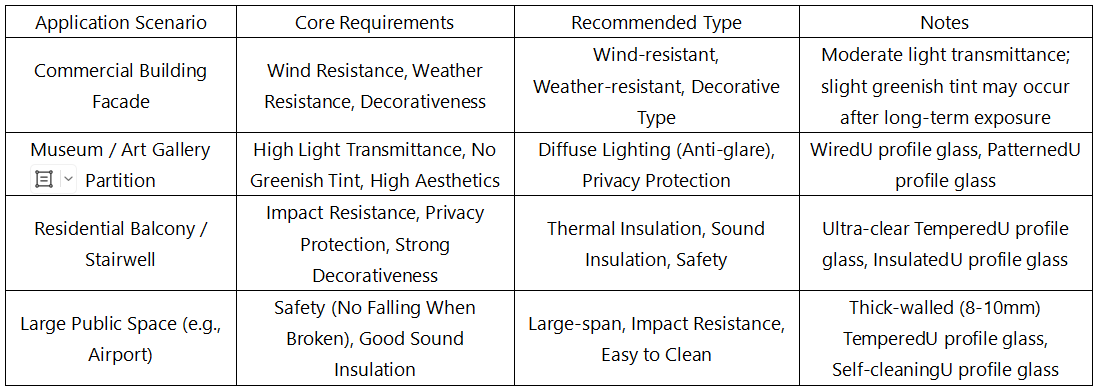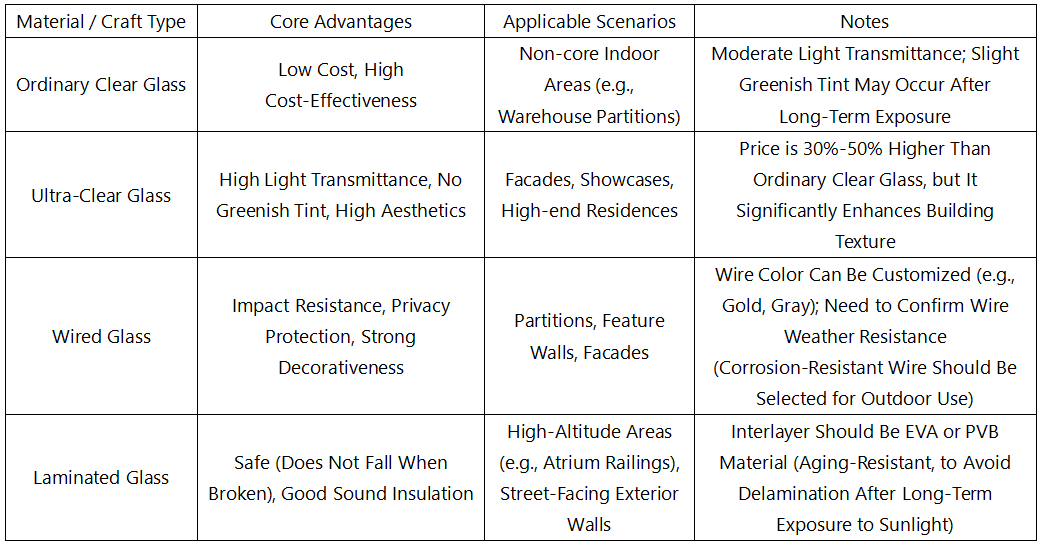The selection of U profile glass requires a comprehensive judgment based on multiple dimensions such as building functional needs, performance requirements, cost budget, and installation adaptability. Blind pursuit of parameters or prices should be avoided, and the core can be carried out around the following key dimensions:
1. Clarify the Core Application Scenarios: Align with Building Functional Requirements
Different building scenarios have significant differences in their performance priorities for U profile glass. It is necessary to first identify the application scenario and then conduct targeted selection.
2. Key Performance Parameters: Avoid “Performance Shortcomings”
The performance of U profile glass directly affects the building experience, and the following 4 core parameters require focused attention:
Thickness and Mechanical Strength
The conventional thicknesses are 6mm, 7mm, and 8mm. For exterior walls/large-span scenarios, 8mm or thicker glass is preferred (offering superior wind load resistance and bending strength).
For areas with high foot traffic (e.g., shopping mall corridors), it is recommended to choose U profile glass with tempered treatment. Its impact strength is 3-5 times that of ordinary glass, and it breaks into blunt-edged particles, ensuring higher safety.
Thermal Insulation (U-Value)
A lower U-value indicates better thermal insulation (blocking heat in summer and retaining warmth in winter).
Ordinary U profile glass has a U-value of approximately 0.49-0.6 W/(㎡・K). For cold northern regions or buildings with high energy-saving requirements (e.g., green building LEED certification projects), insulated U profile glass is recommended (its U-value can be as low as 0.19-0.3 W/(㎡・K)), or it can be paired with a Low-E coating to further enhance thermal insulation.
Sound Insulation (STC Rating)
Conventional U profile glass has a Sound Transmission Class (STC) rating of approximately 35-40. For scenarios with high sound insulation requirements, such as street-facing buildings and hospital wards, laminated U profile glass is necessary. Its STC rating can reach over 43, outperforming ordinary brick walls. Alternatively, the sound insulation effect can be optimized through a combination of “glass + sealant + keel” (gaps are a weak point for sound insulation, so special attention should be paid to installation sealing).
Balance Between Light Transmission and Privacy
For scenarios requiring “brightness without transparency” (e.g., office partitions), choose patterned U profile glass or wired U profile glass. These types diffuse light and block visibility.
For scenarios requiring “high light transmission + aesthetics” (e.g., commercial display windows), choose ultra-clear U profile glass. Its light transmittance is 10%-15% higher than that of ordinary glass, with no greenish tint, resulting in a more transparent visual effect.
3. Material and Craftsmanship: Choose Materials “Suitable for the Scenario”
The material and craftsmanship ofU profile glass directly affect its appearance and durability, so selection should be based on specific needs:
4. Specifications and Dimensions: Match Installation and Building Structure
The specifications of U profile glass need to be compatible with building openings and keel spacing to avoid “cutting waste” or “structural mismatch”:
Conventional Specifications:Bottom Width (U-shaped opening width): 232mm, 262mm, 331mm, 498mm;Flange Height (height of the two sides of the U-shape): 41mm, 60mm.
Selection Principles:
Priority should be given to “standard specifications” (e.g., 262mm bottom width). They cost 15%-20% less than customized specifications and have a shorter delivery cycle.
For buildings with large spans (e.g., 8-meter-high exterior walls), confirm the “maximum producible length” with the manufacturer. The conventional single length ranges from 6 to 12 meters; extra-long lengths require customization, and the convenience of transportation and installation must be considered.
Frame Compatibility:U profile glass needs to be installed with aluminum profiles or stainless steel frames. When selecting specifications, ensure the “glass flange height” matches the frame’s card slot (e.g., a 41mm flange corresponds to a 42-43mm card slot width) to avoid looseness or installation failure.
Post time: Oct-27-2025

